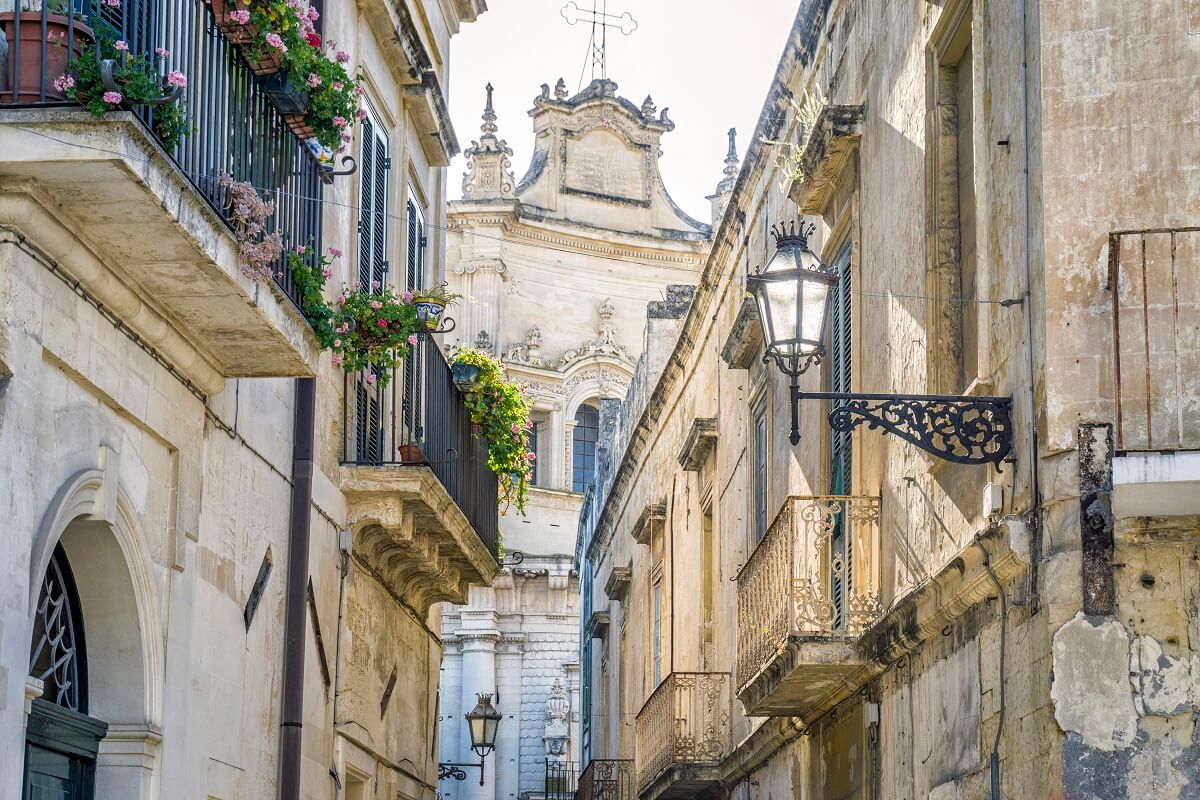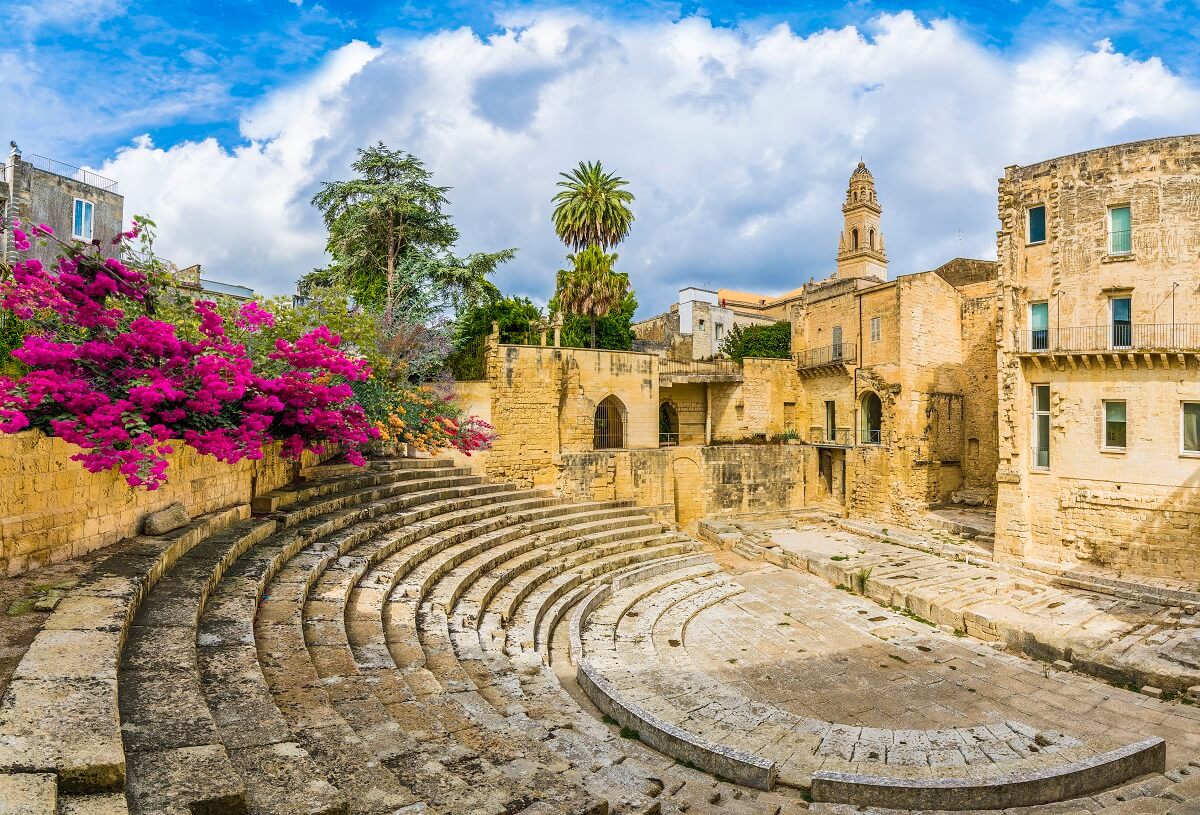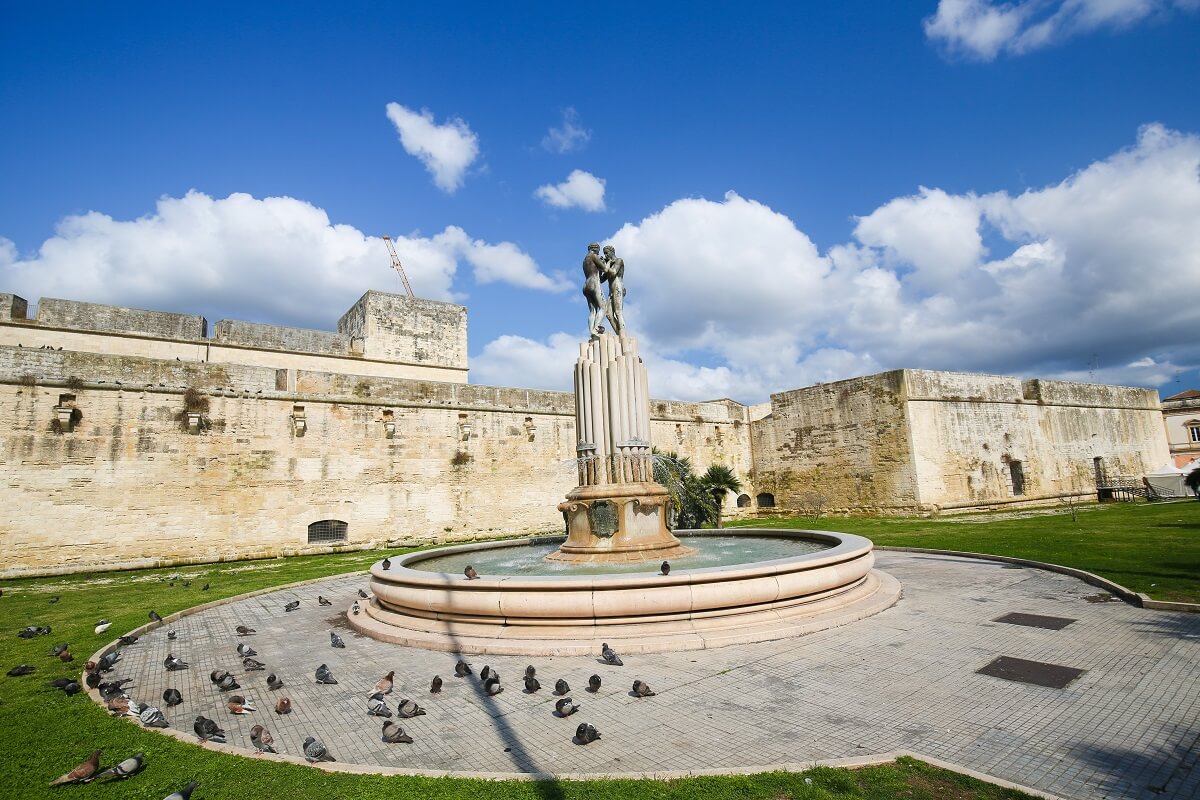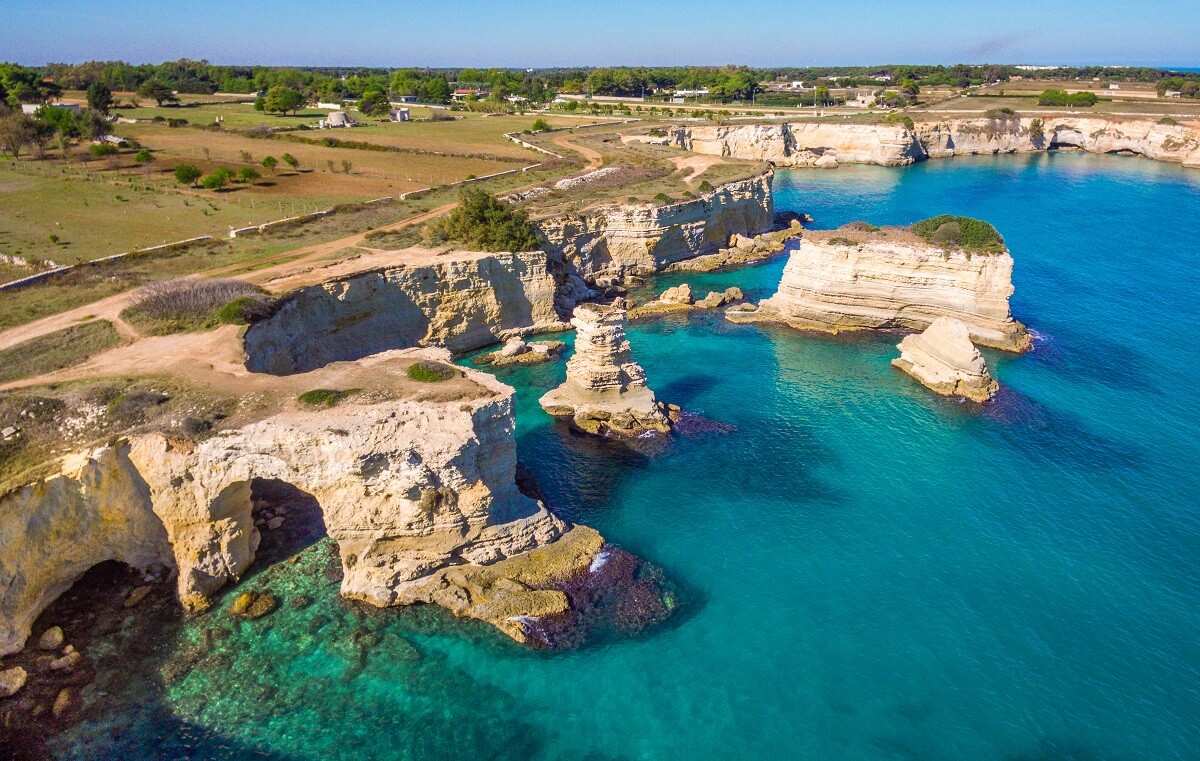
Lecce: the city of the Baroque, churches and scents of the Mediterranean. One of Italy’s most fascinating open-air museums, this city is ideal all year round for a holiday break to enjoy culture, food, and wine.
Looking forward to a relaxing weekend full of culture, art and great food? Plan your trip with Italo to the Baroque pearl of Salento, Lecce: one of Italy’s most beautiful art cities and a summer vacation destination thanks to its beautiful coastline and crystal clear sea. Lecce is a city rich in remains and works of art from Roman, medieval and Renaissance eras and is a gateway to the Maldives of Italy.
You will arrive in the ancient Lupiae, as the Romans called it, the city of stylistic excess, scenic splendor, and that embraces visitors all-year-round. It is located in the heel of Italy, a narrow strip of land dividing the Ionian and Adriatic Seas! Admire its baroque churches, the art of papier-mâché and Lecce stonework. Enjoy food and wine delicacies, breathtaking views, and the fun of the nightlife. Lecce is a university town, full of young people and people-friendly – you can easily visit it in a day, including an out-of-town trip to a coastal destination.
Here are ten things to do and see on a day trip to Lecce:
Where is Lecce in Italy?
- Historic center of Lecce: the gates, churches, and stately buildings
- The Roman Amphitheater
- The Roman Theater
- Piazza Sant’Oronzo: the Seat, the Column and the Church of San Marco
- Piazza Duomo: the Cathedral, the Crypt, the Bell Tower and the Ancient Seminary
- Basilica of Santa Croce and the Celestine Convent
- The Castle of Charles V
- The Giuseppe Garibaldi Public Gardens
- Main shopping street in Lecce
- Salento: the sun, the sea, the wind and… the fun
Where to stay and what to eat in Lecce
- How to get from Rome to Lecce train
- How to get from Bari to Lecce and back
- Train from Brindisi to Lecce
Where is Lecce in Italy?
Nestled in the heel of Italy’s boot, Lecce is a gem of a city in the Puglia region, renowned for its rich history and baroque architecture that captivates visitors from around the globe. Known affectionately as the “Florence of the South,” Lecce is distinguished by its intricate stonework and grandiose churches, which showcase the skill of local artisans. As you wander through its charming streets, you’ll be mesmerized by the ornate facades and elaborate interiors that reflect the city’s storied past.
With a population of around 95,000, Lecce maintains a cozy, small-town feel while offering all the cultural richness one would expect from a larger city. Whether exploring the ancient Roman amphitheater, savoring the local cuisine or enjoying the vibrant art scene, Lecce is definitely worth a visit.
Visit the beauties of Puglia with Italo
Lecce Weather
Lecce’s weather adds another layer of charm to this already captivating city, making it an ideal destination almost year-round. The Mediterranean climate ensures mild winters and warm, sun-filled summers, perfect for exploring the historic sites and enjoying outdoor dining in one of the city’s many picturesque piazzas. Spring and autumn are particularly delightful times to visit, with comfortable temperatures and fewer crowds, allowing you to immerse yourself in Lecce’s rich cultural tapestry and laid-back lifestyle. Whether basking in the summer sun or enjoying the gentle breezes of spring, Lecce’s welcoming weather complements its stunning architecture and vibrant street life, ensuring a pleasant visit for all.
What to Do and See in Lecce, Italy?
Lecce Old Town: the gates, churches, and stately buildings

Start this day tour of Lecce from the historic center and specifically from Porta Napoli, an Arch of Triumph city gate erected in 1548 in honor of Charles V, with the 19th-century Obelisk facing it. Enter the old town and admire the Church of San Luigi Gonzaga, the 19th-century Paisiello Theater, a typical example of an Italianate structure, and the splendid Baroque Palazzo Palmieri.

Continue your walk through the most beautiful streets of the old town and admire the facades of the splendid noble palaces, and don’t miss a visit to the craft stores. Here you will find objects in papier-mâché and Lecce stone made by local artisans. Continue on foot and pause to look at and visit the Church of Santa Maria della Provvidenza, the Church of Santa Maria di Costantinopoli, the Church of San Niccolò dei Greci, the Palazzo Adorno and the Basilica of Santa Croce, the symbol of the city and of Lecce Baroque with the adjoining former Convent of the Celestines.
Reach the central hub of the city, Piazza Sant’Oronzo, the beating heart of city life, and admire the famous column of the patron saint and the Roman Amphitheater. From there, proceed to Piazzetta Vittorio Emanuele II, also known as Piazzetta Santa Chiara, a veritable treasure trove of art, and admire the church of the same name. From the small square, which is characterized by a bustling nightlife, proceed either to the Roman Theater or to Lecce’s second gate: Porta San Biagio without missing the Church of San Matteo, Palazzo Vernazza and Palazzo Giustiniani.

Then head to the scenic Cathedral Square and see the Cathedral‘s opulent side facade and its tall Bell Tower, the 15th-century Bishop’s Palace and the Seminary Building dating from the 18th century, now home to the Diocesan Museum of Sacred Art, the Innocentian Library and the Diocesan Historical Archives.
From here, finish the tour of the historic center in Porta Rudiae, the oldest and most interesting of Lecce’s city gates. During your stroll, admire the three churches that precede it: Church of Santa Teresa, Church of Sant’Anna and the Basilica of the Rosary.
If you’re a garden lover, immerse yourself in the city’s green lung, the Villa Comunale of Lecce, known as the Villa della Lupa, and if you’re in the mood for some shopping, head for the most modern part of the city, Piazza Mazzini surrounded by many stores with its majestic Fountain in the center.

Reach the central hub of the city, Piazza Sant’Oronzo, the beating heart of city life, and admire the famous column of the patron saint and the Roman Amphitheater. From there, proceed to Piazzetta Vittorio Emanuele II, also known as Piazzetta Santa Chiara, a veritable treasure trove of art, and admire the church of the same name. From the small square, which is characterized by a bustling nightlife, proceed either to the Roman Theater or to Lecce’s second gate: Porta San Biagio without missing the Church of San Matteo, Palazzo Vernazza and Palazzo Giustiniani.
Then head to the scenic Cathedral Square and see the Cathedral‘s opulent side facade and its tall Bell Tower, the 15th-century Bishop’s Palace and the Seminary Building dating from the 18th century, now home to the Diocesan Museum of Sacred Art, the Innocentian Library and the Diocesan Historical Archives.
From here, finish the tour of the historic center in Porta Rudiae, the oldest and most interesting of Lecce’s city gates. During your stroll, admire the three churches that precede it: Church of Santa Teresa, Church of Sant’Anna and the Basilica of the Rosary.
If you’re a garden lover, immerse yourself in the city’s green lung, the Villa Comunale of Lecce, known as the Villa della Lupa, and if you’re in the mood for some shopping, head for the most modern part of the city, Piazza Mazzini surrounded by many stores with its majestic Fountain in the center.
The Roman Amphitheater

One of the must-see destinations on your visit to Lecce is in the heart of the city, in Piazza Sant’Oronzo: the Roman Amphitheater, which testifies to the importance attained by the ancient Lupiae in the Age of Imperial Rome. The Amphitheater was discovered in the early 20th century, and you can see about a third of the original building, with part of the arena and cavea, while the remainder is hidden partly under the present square and partly under the blocks where the Church of Santa Maria delle Grazie, the Sedile – the Seat – and Renaissance-style buildings stand. The large Roman structure was capable of accommodating about 20,000 spectators who watched gladiator fights and simulated hunts of wild animals brought in by sea and landed at the Port of San Cataldo.In modern times it has been used as a place to stage the winters Nativity scene, for musical and theatrical events during the summer, and to celebrate the victories of the local U.S. Lecce soccer team.
The Roman Theatre

Another monument of historical significance that you must not miss is the Roman Theater, discovered by chance in 1929 and hidden among the buildings in the Baroque city, a stone’s throw from Piazza Sant’Oronzo and the Duomo. Built in the 1st and 2nd centuries AD, the theater was originally large enough to hold perhaps 5,000 spectators who would attend tragedies and plays there. An interesting fact is that it’s the only Roman theater in Puglia but despite this, few people know about it. Adjoining the theater, you will find the Roman Theater Museum, established by the Memmo Foundation, which displays some artifacts found during excavations, the exhibit entitled Rome – a life scene, some theater masks from Hadrian’s Villa in Tivoli, and a model of Lecce in the Age of Imperial Rome.
There’s a charge for admission to the Museum, with guided tour on request, Monday through Saturday from 9.30 am to 1.00 pm. Afternoon visits are by reservation only.
Piazza Sant’Oronzo: the Seat, the Column and the Church of San Marco

After visiting the Roman archaeological finds, stop at Lecce’s most important square: Piazza Sant’Oronzo, a square of many different layers and styles that now coexist together. In ancient times, Piazza Sant’Oronzo had a different layout: the location of the current Amphitheater was occupied by a small hamlet that was destroyed during archaeological excavations. Since 1656, the square has been named after the patron saint of Lecce, Saint Oronzo following the ravages of the plague.
Admire the majestic Column, 29 meters high, made in Brindisi with materials obtained from two Roman columns. A bronze statue dedicated to the patron saint was erected on it in 1666, designed by Giuseppe Zimbalo as a votive offering of the citizenry. To the right of the column, you will find the 16th-century Seat, a majestic cubic building, and the small Church of St. Mark a little late Renaissance jewel from 1543 founded by a Venetian colony. In addition, admire the Fascist architecture of the INA Building that follows the curve of the Amphitheater, and stroll under its arcades, the Bank of Italy Building, and in one corner of the square, remember to take a picture of the clock with the world’s largest clock face made of bronze and enamel by artist Francesco Barbieri.
Piazza Duomo: the Cathedral, the Crypt, the Bell Tower and the Ancient Seminary

From Piazza Sant’Oronzo, head for Lecce Cathedraland stroll along the Corso among stores, other historic buildings and the Church of St. Irene, named after the city’s patron saint up to 1656. Piazza Duomo, formerly the Roman Forum, is one of the most interesting enclosed squares in Italy; it has a single entrance and is flanked by signature Lecce Baroque architecture. Admire the Bell Tower and the facades of the Cathedral, the Episcopate and the Ancient Seminary. Visit the cathedral, founded in 1144, rebuilt in 1230 in Romanesque style, and later in Baroque style by Zimbalo in 1659, dedicated to Mary of the Assumption. Don’t miss the 92 columns of the Crypt, located under the chancel of the cathedral and dedicated to Our Lady of the Stairs, dating back to 1517, and the Diocesan Museum of Sacred Art in the Ancient Seminary, where you can admire paintings, sacred silverware, sculptures, liturgical vestments and, in the inner portico, the magnificent well.
The museum is open from April to September from 09.00 am to 9.00 pm every day, and from October to March from 09.00 am to 6.00 pm. The ticket cost is €9 and includes the LeccEcclesiae tour: Duomo, Santa Croce, Santa Chiara, San Matteo and Museum of Sacred Art.
Basilica of Santa Croce and the Celestine Convent

A must-see on your visit to Lecce is the most significant building of Lecce Baroque architecture: the Basilica of Santa Croce, one of the most important and admired churches in Lecce, completed in 1699. Behold its splendid facade, a veritable manifesto of artistic virtuosity and technical expertise. It affords an unexpected view, a show of stone in which you can notice the splendid columns and balcony with balustrades along with a wealth of decorations, bas-reliefs, and sculptures in Lecce stone, the work of Cesare Penna based on a design by Giuseppe Zimbalo. Admire the large rose window, decorated with floral friezes, bunches of fruit and cherubs. Visit the interior with its Latin cross plan, hemispherical dome, and three naves divided by columns with carved capitals, wooden ceiling, rich interior furnishings, and the altar of St. Francis of Paola, decorated with twelve bas-reliefs depicting the Saint’s life. Adjacent to the Basilica of Santa Croce, you find the Palazzo dei Celestini, for three centuries home to the convent of the Celestine Fathers; also known as the Government Palace, it is now the seat of the Prefecture and the Lecce Provincial Administration. It is a baroque-style palazzo; also in this case, designed by Giuseppe Zimbalo in the same style as the church facade. In short, a unique scenic square that leaves you speechless.
The Castle of Charles V

The Castle of Charles V is another wonder of this city. It was erected in the 16th century at the behest of the ruler and in response to the need for defense against enemy attacks, both as a symbol of the king’s greatness and power. Behold this imposing and massive structure that stands out prominently in the city’s urban layout and the splendid Fountain of Harmony.
You can visit the castle from June and September, Monday through Friday from 9.00 am to 9.00 pm, and Saturday, Sunday, and holidays from 9.30 am to 9.00 pm. July and August Monday through Friday from 9.00 am to 11.00 pm and Saturday, Sunday and holidays from 9.30 am to 11.00 pm. The cost of the full ticket is €5.
The Giuseppe Garibaldi Public Gardens

For a relaxing break, head to the Giuseppe Garibaldi Public Gardens, better known as Villa Comunale or Villa della Lupa. The Villa, built in the early 19th century, is currently structured as one of the largest and most beautiful Italian gardens in the city. Admire the various fountains, marble and stone busts, plants, ancient trees, and a circular temple, and enjoy watching the little ones in the two play areas. It is strategically located – you can reach it from the nearby old town and then arrive in the new part of town and indulge in some shopping or visit another important square: Piazza Mazzini and its majestic stone fountain.
Main Shopping Street Lecce
For those who delight in retail therapy, Lecce’s main shopping street, Via Trinchese, offers a wonderful blend of modern allure and historical charm. This bustling thoroughfare is the heart of Lecce’s shopping scene, lined with a variety of stores from high-end boutiques to traditional handicraft shops. As you stroll along Via Trinchese, you can admire the stunning baroque architecture that frames the street, making your shopping experience uniquely scenic.
Whether you’re searching for the latest Italian fashion, unique local crafts, or fine regional wines, Via Trinchese provides a delightful shopping experience in the historic setting of one of Italy’s most beautiful cities. This vibrant street not only caters to all tastes and budgets but also invites you to explore the quaint cafes and gelaterias where you can pause to savor the local flavors between your shopping adventures.
How far is Lecce from the Beach?
Lecce is relatively close to several beautiful beaches on the Adriatic and Ionian Seas, making it an excellent base for beach lovers. The closest beaches are about a 20 to 30-minute drive from the city center. On the Adriatic coast, you’ll find beaches like San Cataldo, which is approximately 12 miles (about 20 kilometers) away, offering easy access via car or public transportation. For those seeking the pristine waters of the Ionian Sea, the popular beaches around Porto Cesareo are about 17 miles (around 28 kilometers) to the west of Lecce. These distances allow for easy day trips, so you can enjoy a morning in the city and an afternoon relaxing by the sea.
Salento: the closest beach to Lecce

Over the past 15 years, Lecce’s coastal Salento area has become Italy’s most popular seaside destination thanks to the beauty of the sea and the hospitality of its inhabitants. From Lecce you can reach some of the most beautiful beaches in the world, with crystal clear waters that you find only in a few other places in the Mediterranean:
- Punta Prosciutto,
- Punta della Suina,
- Porto Selvaggio,
- Porto Cesareo,
- Santa Cesarea Terme,
- Santa Caterina,
- Castro,
- Torre dell’Orso,
- Leuca.
Visit the villages – some very famous, like Otranto and Gallipoli, but also less well-known ones with stunning stonework backdrops like Galatina, Nardò, Presicce, and Specchia.
Where to stay and what to eat in Lecce
In Lecce, the booming tourism scene has created a wealth of hospitality facilities. Today, the Apulian city offers you a great range of hotels, bed&breakfasts, agritourisms and in the historic center even luxury hotels. But you also have a great alternative: old farmhouses just outside the city, near the sea or among olive trees. They are mostly old renovated farmhouses, many of them with swimming pool.
What to Eat in Lecce

Finally, in Lecce, you simply must try the excellent cuisine: from the fruits of the earth and sea to the spices of the Mediterranean maquis to vegetables and legumes cooked in an earthenware pot, seasoned with extra virgin olive oil and served with friselle, a toasted, biscuit-like bread. Remember to try rustico leccese, two puff pastry disks filled with mozzarella cheese, béchamel sauce, tomato, pepper and nutmeg. Try taralli, focaccia, cheeses, mozzarella; sample puccia, a small, round wheat bread that, if it is not to be stuffed, includes black olives in the dough. For desserts, enjoy the world-famous pasticciotto leccese, which should be eaten strictly hot, and try a host of delights prepared with almond paste. For wines, taste Negramaro, Salice Salentino, and Primitivo di Manduria, which are just some of the native Salento wines that stand out for their full-bodied color and flavor. In short, in Lecce, you can fully satisfy your palate and experience days of good taste, beauty, culture, and fun all year round!
To Lecce with Italo
Set out to discover Lecce and its wonders and enjoy a unique travel experience thanks to Italo’s new connections with regional buses and trains. Discover itineraries and connections and buy your ticket on Italotreno now. If you haven’t already done so, you can sign up for the Italo Più Loyalty Program for free, get 5% off your first trip right away, and collect points with your trips to claim free award tickets.
You can purchase tickets online through various platforms like Italo, or at the train station. Once in Lecce, the train station is conveniently located near the city center, making it easy to start exploring the city right away.
How to Get from Rome to Lecce by Train?
Traveling from Rome to Lecce by train is a convenient and scenic option that allows you to relax and enjoy the beautiful Italian landscape. To make this journey, you can board a high-speed train from Rome’s main train station, Roma Termini, to Lecce. The fastest route typically involves taking a Italo train to either Bari or Brindisi, and then transferring to a regional train that will take you directly to Lecce.
Trains from Rome to Bari
The entire trip can take anywhere from 5 to 7 hours, depending on the specific train schedules and the length of any transfers. It’s advisable to book your tickets in advance, especially during peak travel seasons, to secure the best fares and ensure availability.
How to get from Bari to Lecce?
Getting from Bari to Lecce is quite straightforward, thanks to the well-connected train services in the region. Trains from Bari to Lecce are frequent, with the journey typically taking about 1.5 to 2 hours depending on the service you choose. On Italo’s website you can buy your ticket to travel throughout Italy by connecting with Trenitalia’s regional networks.
How to get from Rome to Lecce via Naples by train?
Traveling from Rome to Lecce via Naples by train offers a fantastic opportunity to explore two of Italy’s vibrant cities. Start your journey at Roma Termini, where you can catch an Italo high-speed train to Naples. This leg of the trip typically takes about 1 to 1.5 hours, allowing you some time to enjoy Naples’ rich history, exquisite cuisine, and lively atmosphere.
After exploring Naples, you can continue your journey to Lecce. Italo provides a direct bus service from Naples to Lecce, which is a comfortable and convenient way to travel the remaining distance. This part of the journey usually takes between 5.5 to 6.5 hours. The entire trip, including a brief stopover in Naples, typically spans between 7 to 8 hours.
This travel option not only gets you to your destination efficiently but also enriches your trip with a brief visit to one of Italy’s most iconic cities. It’s advisable to check the latest train and bus schedules and book your tickets in advance to ensure a smooth journey.
How to get from Brindisi to Lecce?
Traveling from Brindisi to Lecce by train is a quick and convenient option. The journey typically takes about 30 minutes to an hour, depending on the type of train service you choose. Both Trenitalia and the regional rail provider, Ferrovie del Sud Est (FSE), operate trains between these two cities, offering frequent daily connections.
Travel from and for Brindisi with Italo High Speed Train
You can start your journey at Brindisi’s central train station, which is well-served by both regional and faster intercity trains. Regional trains are usually the most frequent and cost-effective option for this short trip.



